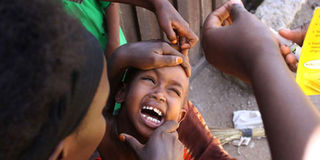War on preventable diseases in full gear

Polio vaccination at Kambi Odha in Isiolo County on January 18, 2017. PHOTO | FILE | NATION MEDIA GROUP
What you need to know:
- Some facilities have reported success in mother-to-child HIV transmission.
- Elephantiasis, a parasitic infection transmitted through mosquitoes and is prevalent in the coastal counties, is also about to become history.
- Also on the radar of elimination is cervical cancer and hepatitis C.
All nations have aspired to eliminate disease since the advent of modern medicine and vaccines. The epitome of that aspiration was in 1980 with the elimination of smallpox — termed as a “victory for all mankind.”
We have since made comparatively lesser progress in ridding ourselves of infectious diseases. But there is renewed optimism.
In February, the World Health Organisation certified Kenya free of Guinea worm disease on the recommendation of the International Commission for the Certification of the Dracunculiasis Eradication (ICCDE). That made GWD the second human disease to be eliminated.
Kenya is also slated to eliminate maternal and neonatal tetanus this year. In the late 1980s, tetanus used to kill seven out of every 1,000 children born alive but that is down to less than one per every 1,000 — a reduction of 90 per cent.
HEALTH SYSTEMS
The government, in February, conducted a thorough evaluation of our health systems and we are confident that we are on track to achieve this. We are also on course to eliminate mother-to-child transmission of HIV as well as congenital syphilis by 2021.
Some facilities have reported success in mother-to-child HIV transmission. Rongo Sub-County Hospital and Rapogi Health Centre recorded no infant transmissions last year. We aspire to eliminate congenital syphilis using the same platforms.
Elephantiasis, a parasitic infection transmitted through mosquitoes and is prevalent in the coastal counties, is also about to become history.
BLINDNESS
Beginning this year, the Ministry of Health will be working closely with county governments and other partners to track the few remaining cases and launch a vigorous campaign for their elimination by 2020.
In many pastoralist counties, trachoma is a debilitating disease that causes blindness and is mainly transmitted by flies under unhygienic conditions. As 2019, our target year of elimination, approaches, we will provide trachoma surgeries to 41,500 people and antibiotic treatment to 2.8 million others.
Despite progress with measles vaccinations, recent reductions in vaccination rates due to strikes by health workers has hampered our efforts to bring the disease under control. With a stable health sector, however, we are confident that it can be eliminated as we have the knowledge and sufficient stocks of vaccines. In this decade, there is no reason for any child to acquire measles.
VIRUS
Regarding polio, there are only three countries — Afghanistan, Pakistan and Nigeria — where it is still an ongoing problem while elsewhere, such as Somalia, there have been intermittent circulations of the virus.
In Kenya, the last case of wild polio virus was recorded in 2013 and the country is supportive of the global effort to control it.
We face challenges as a result of potential importation of cases from Nigeria and Somalia. Given the extent of global travel and instability in the region, we are working with international partners, including the UNHCR, to limit transmission from refugees and other mobile populations.
VIGILANCE
More importantly, we are maintaining a high level of vigilance to detect any case of polio that may have been imported. Equally, we are providing multiple opportunities for polio vaccinations to our own population as well as refugees and nomads entering our country.
As Bill Gates avers, “We have completely eradicated smallpox; we have almost eradicated polio. That’s the miracle of vaccines, which is even greater than that of antibiotics”.
We, therefore, need to enhance our immunisation campaigns and we call upon our partners to rally together with the ministry in this last-mile sprint to eliminate vaccine-preventable illness. Also on the radar of elimination is cervical cancer and hepatitis C.
VACCINATIONS
With the HPV vaccinations coming up next year, coupled with rigorous screening and treatment of pre-cancerous lesions, cervical cancer can be beaten in a decade. The same for Hepatitis C, for which we have safe and efficacious treatments that are now provided particularly for people who inject drugs.
Kenya fully supports the London Declaration to Sustain, Expand and Extend programmes that ensure the necessary supply of drugs and other interventions to help eradicate the neglected tropical diseases outlined.
The next five years will be exciting for Kenya as we knock down one disease after the other. That will be a significant contribution to Kenya’s journey to universal health coverage (UHC).
We are confident that, in our generation, and most likely in the next decade, we will eliminate many diseases and, indeed, achieve UHC. But the time to act is now.
Mrs Kariuki is the Cabinet Secretary, Ministry of Health. Dr Eggers is the WHO Representative, Kenya.





